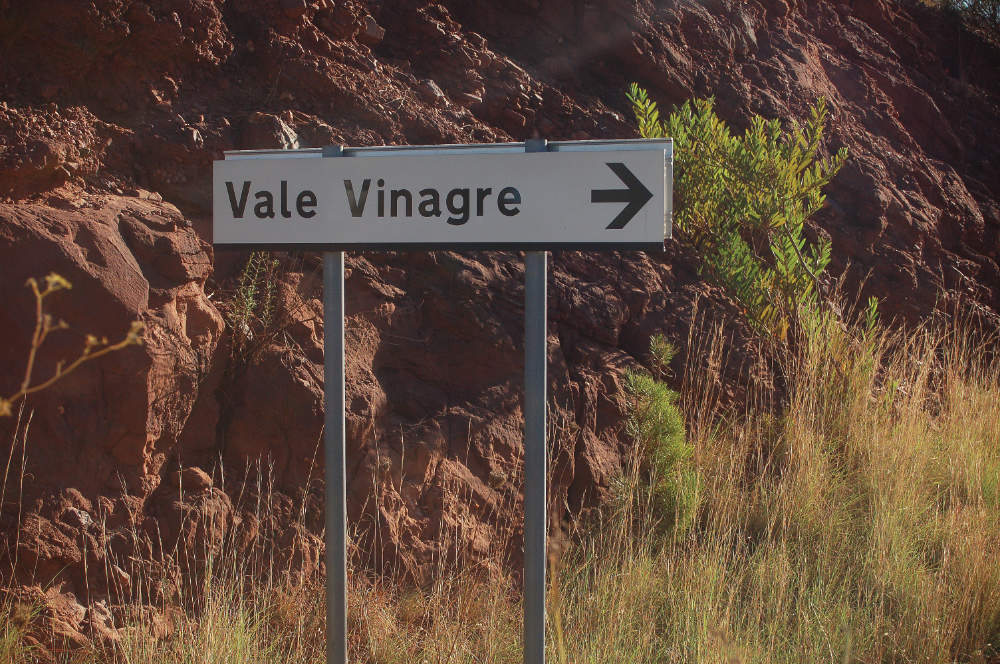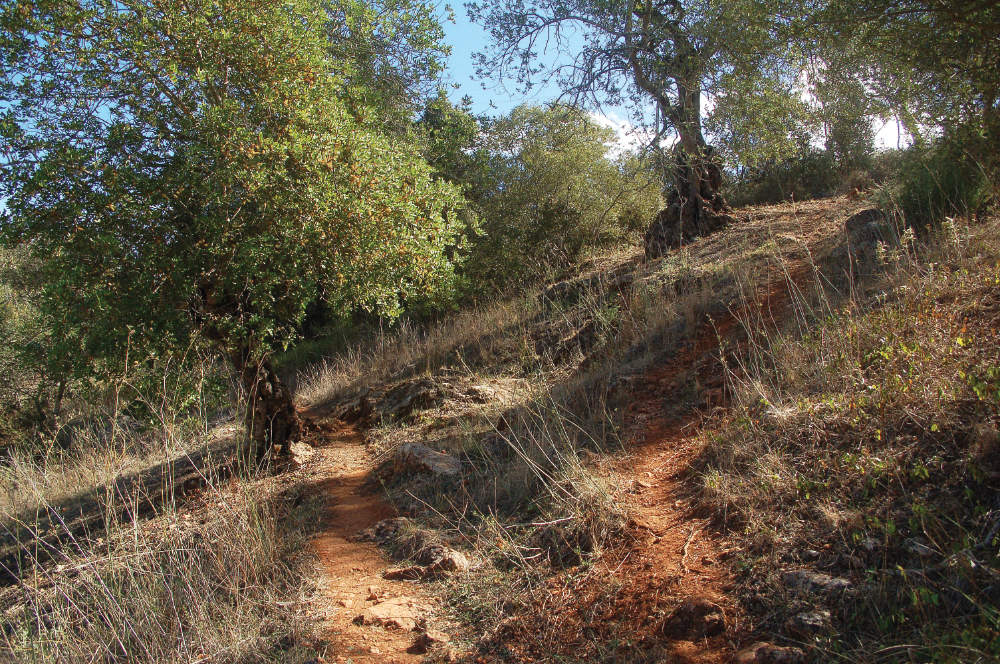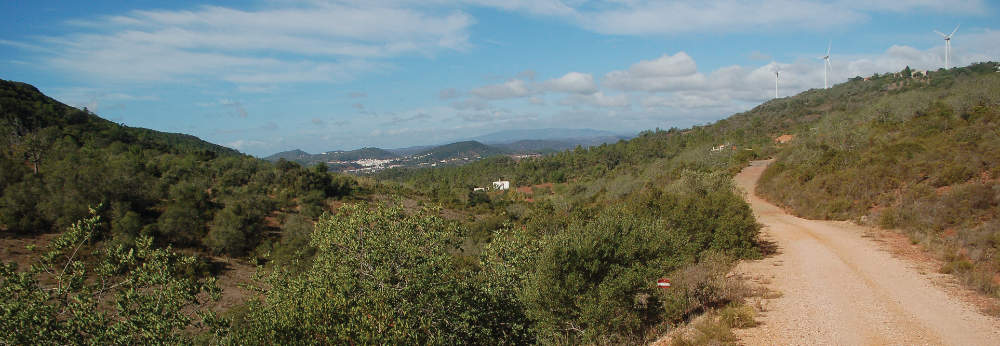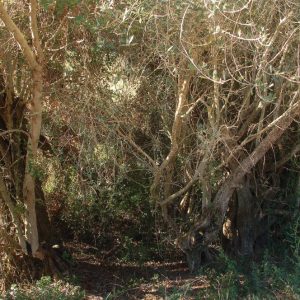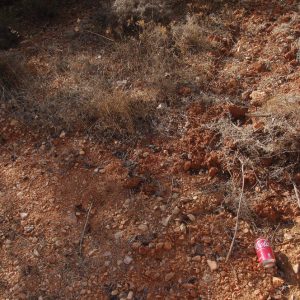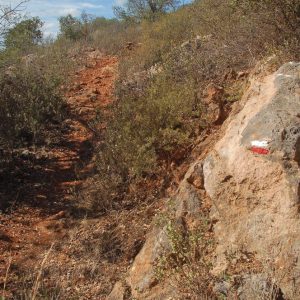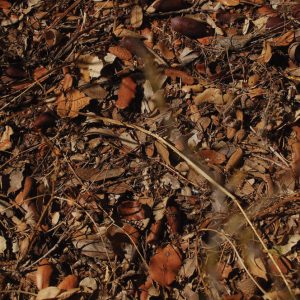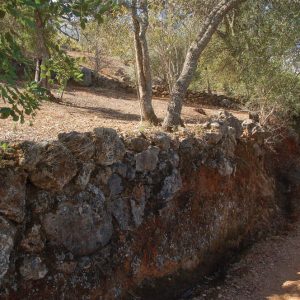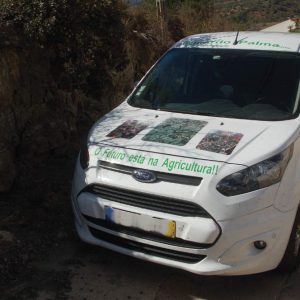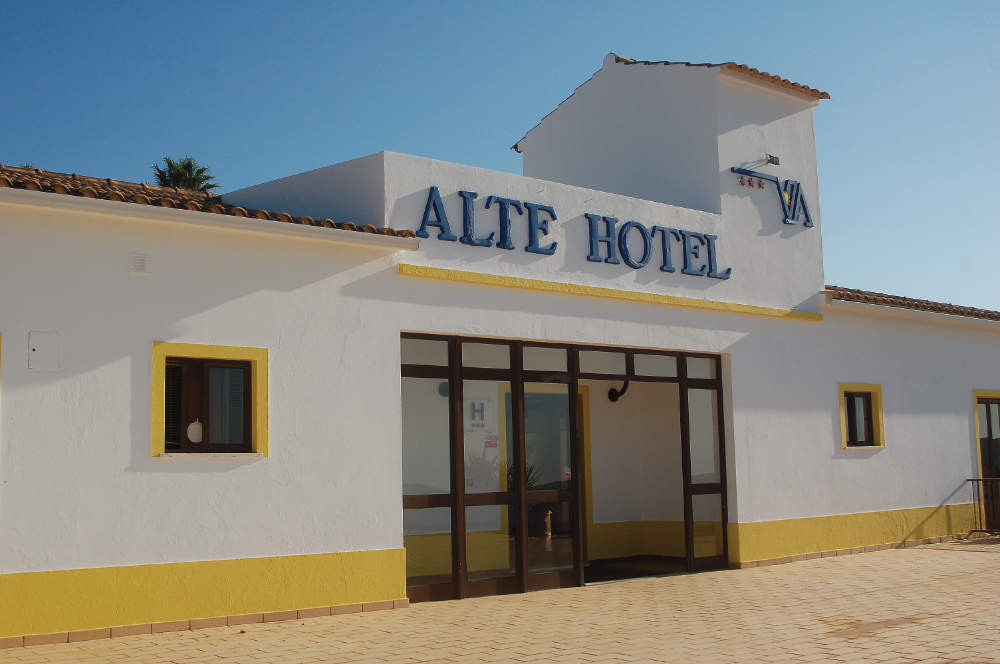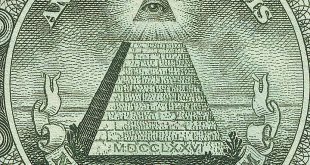I order my breakfast from next door. The price is 2 euros and forty cents and it’s eight o’clock when I hand over the key at reception and walk across to Senhor Jorge. One hot milky coffee and a cheese roll please. Bom dia. Two minutes later everything is standing on the counter and I take my breakfast outside onto the terrace. Messines has already woken up and I am studying the way ahead on the map. Aiming for the Vale Vinagre I am soon starting my small ascent. First of all out of town and through the underpass of the motorway connecting the Algarve with the heart of the country. There are trails and crossroads everywhere. Turning off right and left again, after a few hundred metres a sign points me towards Vale Vinagre. The tarred road turns into a gravel track, and after an hour of walking out of town I reach a plot of land belonging to Dutch citizens. There’s a bench and a sign and a rubbish bin under a carob tree, as well as a little booklet with a pen and the request to leave a message. Two wooden clogs hang on a nail, inviting me to sit down and look at a garden with traditional trees, surrounded by palm trees: stands of pomegranate, carob and olive, fig and almond trees. I take a seat and a rest. It’s the 21 October of the year 2021 and for the first time I feel welcomed, with respect, as a hiker. Thank you!
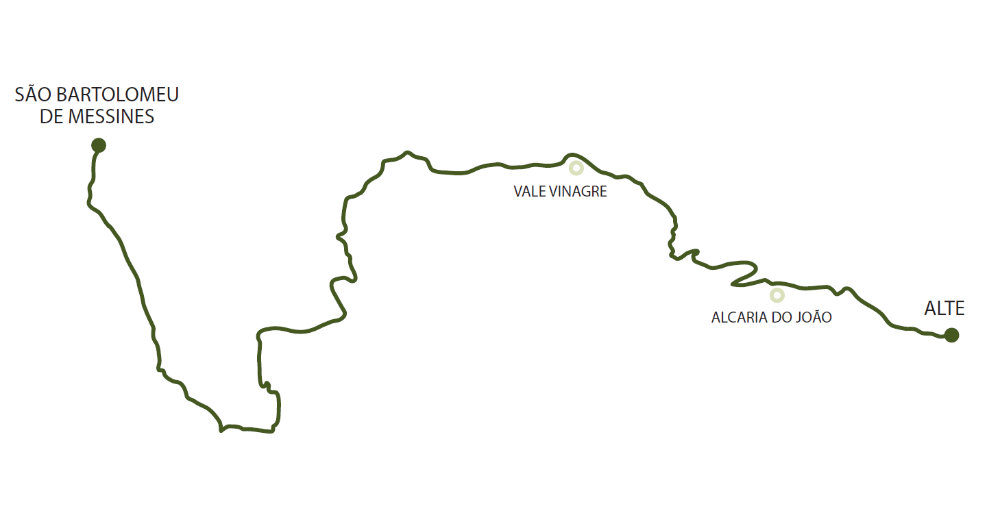 Onwards and upwards. I meet an old couple harvesting olives the traditional way. I ask these two whether their land still belongs to Silves or is already part of Loulé? The elderly gentleman comes closer and puts his own question to me, where do I come from? I name the village where I live and that I call home. Yet he looks at me distrustfully and tells me to my face that I’m a foreigner, right? He himself has spent many years in France, working. He has a plot of land to spare and asks me straight out whether I am planning to buy something here. No, I reply, I have land of my own, and no, I don’t need another house. Undeterred, he won’t let it go and starts telling me he has another house up his sleeve, with only 1000 m² and a fine set of trees. I refuse, thanking him and repeat my question. His „quinta“ here still belongs to Silves, he tells me, which changes however up there at the trail level. He points his finger in a direction of a construction site. Up there marks the start of Loulé, the largest district in the Algarve.
Onwards and upwards. I meet an old couple harvesting olives the traditional way. I ask these two whether their land still belongs to Silves or is already part of Loulé? The elderly gentleman comes closer and puts his own question to me, where do I come from? I name the village where I live and that I call home. Yet he looks at me distrustfully and tells me to my face that I’m a foreigner, right? He himself has spent many years in France, working. He has a plot of land to spare and asks me straight out whether I am planning to buy something here. No, I reply, I have land of my own, and no, I don’t need another house. Undeterred, he won’t let it go and starts telling me he has another house up his sleeve, with only 1000 m² and a fine set of trees. I refuse, thanking him and repeat my question. His „quinta“ here still belongs to Silves, he tells me, which changes however up there at the trail level. He points his finger in a direction of a construction site. Up there marks the start of Loulé, the largest district in the Algarve.
A good soil which supports a very old population of trees here. Along the way there are botanical surprises. Three wind generators, constantly turning, are producing clean energy. At Alcaria do João the farm road becomes a hiking trail using old crisscrossing farming trails, forming small hairpin bends, and leading over strong roots of carob and olive trees. Former terraces, walnuts on the ground, almonds and carob. I start foraging, if quite selectively. The Via Algarviana, the former pilgrimage trail is given an interesting routing here, which finally leads past inhabited houses. A soil made for subsistence agriculture with chickens, ducks and geese. Dogs are barking and an old Moorish fountain occupies the centre of the plot of land. The stands of trees, some of them hundreds of years old, are resisting well to the drought and heat.
The weather report forecasts the highest daily temperatures at 30 degrees Celsius, dry weather and northwesterly winds. Looking back onto the Monchique massif from a distance of 70 kilometres proves to me what a set of two legs can achieve over three days, a magnificent perspective up and back on a clear autumn day. I start imagining that I’ll now tackle the way up into the Serra do Caldeirao, the second low mountain range of the Algarve. Slightly lower in altitude, it runs from north to south, dividing the Barrocal from the Litoral. This is where all the brooks and rivers of the Algarve have their origin, the Rio Odeleite and the Rio Foupana, flowing eastwards into the Guadiana, and the Rio Arade which flows first westwards, then south however, to meet the southern Atlantic at Portimão.
I’m now travelling on my own nearly the whole time. All of a sudden, just before reaching Alte I get the feeling of having arrived in the heart of the Algarve. Each way, it’s still 150 km westwards to the southwestern cape, and the same distance eastwards to the Spanish border and the Guadiana River at Alcoutim. I’ve now arrived well within myself, and I have the feeling that my feet will carry me, no matter how far, no matter where to. Before I used to walk this trail every year and knew every house and every old tree. From here it’s two kilometres to Alte and that’s the place I call now on the phone, my overnight accommodation where I booked a room a few days ago.
Food for those who don‘t eat meat?
 Standing at reception I find a Via Algarviana visitor‘s book on the counter. There is no entry for 2020, the year is completely omitted. Greetings from Covid-19. 2020 was a catastrophic year for all forms of tourism, yet it is the first and only good year for the climate, with a drop in CO2 emissions by eight per cent. Not a single hello to other hikers in the visitor’s book. The Alte Hotel has somehow survived the Corona pandemic and I’m glad. Some 30 rooms and a restaurant offer hikers in the heart of the Algarve hinterland a pleasant all-round support service. There are regions where hikers have to take their tent these days as the pensions weren’t able to weather the economic ravages of the pandemic. Key in hand I go to my room with the number 106. I change my clothes and start washing my undies, t-shirt, shirt and socks in the washbasin of my room, with olive soap. Why not take advantage of the sunny afternoon and my view of the kitchen and staff entrance to string a washing line across the balcony and to ask the sun and the wind to dry the washed clothes as quickly as possible? Some hotels ban hikers from washing their smalls for aesthetic reasons. They have a payable laundry service for their guests, which usually takes a long time however, if it’s working. I always do my own laundry, as I need my thing the next morning straightaway, dried. And aesthetics mean different things to different people, as we know. Few clothes in my backpack means little weight on my shoulders. I want to carry on walking early the next morning.
Standing at reception I find a Via Algarviana visitor‘s book on the counter. There is no entry for 2020, the year is completely omitted. Greetings from Covid-19. 2020 was a catastrophic year for all forms of tourism, yet it is the first and only good year for the climate, with a drop in CO2 emissions by eight per cent. Not a single hello to other hikers in the visitor’s book. The Alte Hotel has somehow survived the Corona pandemic and I’m glad. Some 30 rooms and a restaurant offer hikers in the heart of the Algarve hinterland a pleasant all-round support service. There are regions where hikers have to take their tent these days as the pensions weren’t able to weather the economic ravages of the pandemic. Key in hand I go to my room with the number 106. I change my clothes and start washing my undies, t-shirt, shirt and socks in the washbasin of my room, with olive soap. Why not take advantage of the sunny afternoon and my view of the kitchen and staff entrance to string a washing line across the balcony and to ask the sun and the wind to dry the washed clothes as quickly as possible? Some hotels ban hikers from washing their smalls for aesthetic reasons. They have a payable laundry service for their guests, which usually takes a long time however, if it’s working. I always do my own laundry, as I need my thing the next morning straightaway, dried. And aesthetics mean different things to different people, as we know. Few clothes in my backpack means little weight on my shoulders. I want to carry on walking early the next morning.
The life of a walker is determined by practical issues, based on experience. I am carrying very little luggage. These days, shop assistants in specialised clothes stores try in vain to talk me into buying clothing, including hiking boots which might be pretty and fashionable, but have little practical use. I no longer buy foreign products transported all the way here from the Far East (for instance from China, Vietnam or Myanmar). And functional clothing for hikers isn’t even that good value. Often all you are paying for is the name of the shoe manufacturer, same thing for undies and t-shirts, and even the hiking trousers „Made in PRC“ from a French sports brand will cost at least the freedom if not the life of the Uigurs. Also, I no longer buy socks from international outfitters. Instead I order my hiking socks privately and have them made by hand. They are knitted from natural linen, an old craft using five needles which up to recently was still an option for the long-distance hiker in a cooperative in Cachopo (Tavira district). Then one of its four members died, and the cooperative closed down again. A shame really, as the hand-made socks from Cachopo in the Serra do Caldeirão count among the best I’ve ever had. They have been good to my feet on long hikes. Linen you see is a made from flax which is spun and looped onto a spindle. Linen is one of the best fabrics for natural clothing. In the olden days, linen used to be turned into underwear in Alte, Salir and Cachopo, used for knitting socks and even for weaving trousers, jackets and dresses. I don’t go in for cotton nor sheep’s wool, not to mention acrylic fibres made from petroleum, as no other fabric offers such excellent properties on long-distance trails as natural linen. Linen breathes, it’s a completely natural fabric which doesn’t absorb sweat. It takes seven steps to turn flax into a strong evenly spun thread: carding, rippling, drying, breaking, swinging and hackling; the terminology of an old craft that has nearly died out because clothes manufacturing has been turned into an industry, with the machines being shipped to the Far East.
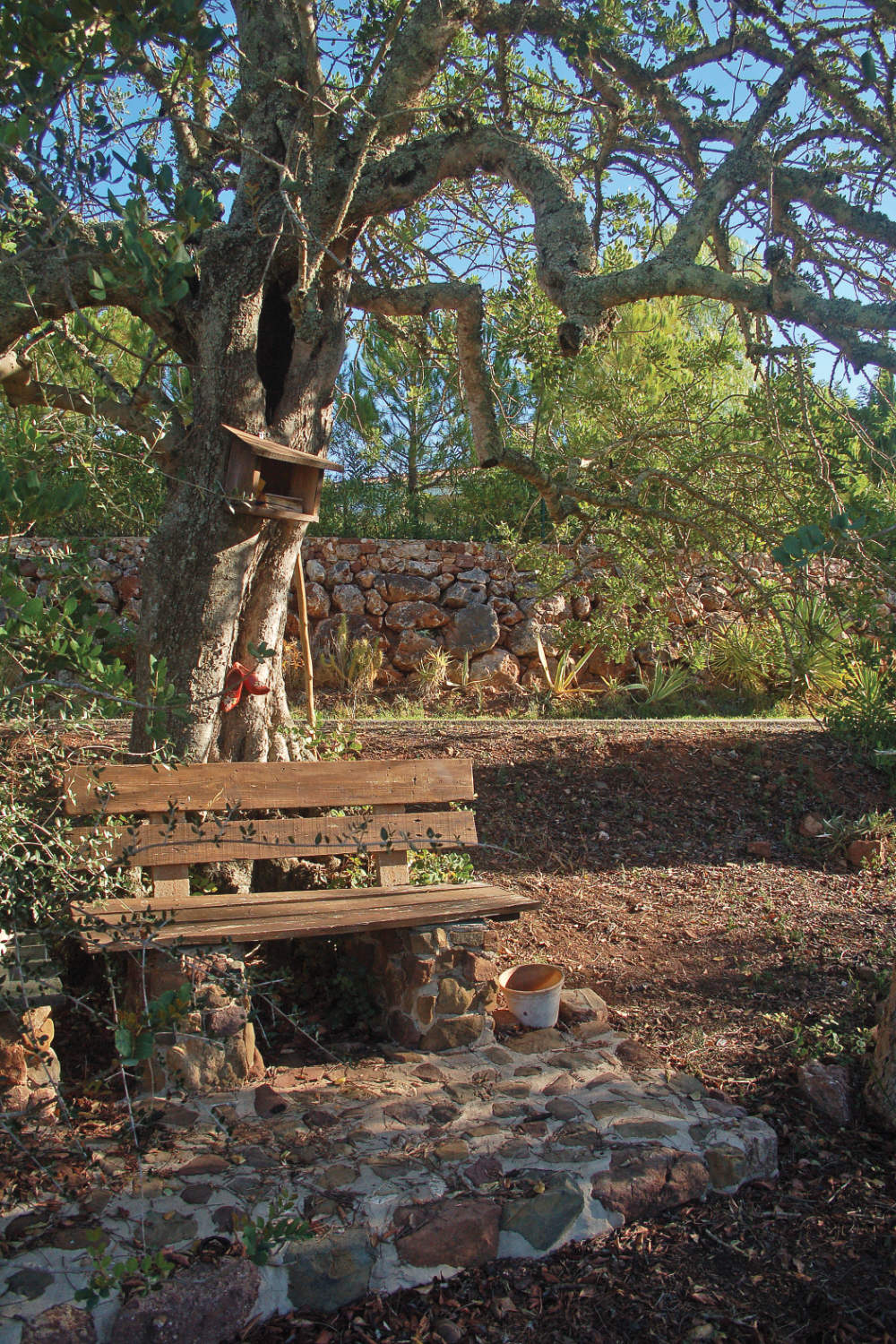 The local craftswomen however, when spinning, pull the fibres from the distaff, also called rock, and twist the flax continually into a strong thread. This may be done by a hand spindle or a spinning wheel. The flax plant always grows near wetlands. As opposed to this kind of craft, today’s clothing industry is responsible for more CO2 emissions than aviation and shipping taken together. This makes me worry, but also makes me act. Have we humans lost touch with nature with our clothing as well? I prefer locally produced clothing made from natural fibres, wherever it is still in existence.
The local craftswomen however, when spinning, pull the fibres from the distaff, also called rock, and twist the flax continually into a strong thread. This may be done by a hand spindle or a spinning wheel. The flax plant always grows near wetlands. As opposed to this kind of craft, today’s clothing industry is responsible for more CO2 emissions than aviation and shipping taken together. This makes me worry, but also makes me act. Have we humans lost touch with nature with our clothing as well? I prefer locally produced clothing made from natural fibres, wherever it is still in existence.
So why have they built a museum in Cachopo instead of continuing the centuries-old craft – or revive it even? The best person to explain this to me will be Dona Otilia Cardoso. She heads the museum in Cachopo, which is surely worth a visit. I would buy a dozen of these socks off her, produced locally from this natural material, if they were still available. And I’m sure that nearly every hiker coming through Cachopo on the Via Algarviana would do the same if linen socks were on offer for sale. We can see how important climate-friendly production of clothing has become for the customer, by the fact that all of a sudden nearly all international fashion labels want to fight climate change. Hello greenwashing. Fighting climate change? That would mean to bring back production from Asia to Europe, to Portugal, to Cachopo or Alte, in any case locally. And then there’s the question which fabrics, which material the clothing industry uses to create its fashion? Three practical steps in the direction of climate neutrality would be the use of natural fabrics, recycling them, and only allowing them to travel short distances. This is something completely different to the greenwashing by a certain sports shoe manufacturer by the name of Nike.
Alongside clothing, food production represents another significant source of CO2 emissions. The cuisine of the Algarve still offers far too few sophisticated dishes for vegetarians and vegans. In the hinterland of Portugal, vegetarians are a neglected species. This may be about to change significantly, and the Algarve should start preparing itself today rather than tomorrow for target groups following a meat-free diet. In the year 2020 global turnover for vegan products worldwide stood at around 17 billion dollar, or 13 billion euro. Analysts are tripping with the rising growth rates: the Boston Consulting Group consultancy firm is expecting an annual turnover of 290 billion dollars in the year 2035, the Credit Suisse Research Institute even talking about 1.4 trillion dollars in 2050. Which is why a lot of money is currently being channelled into this sector.
The menu describes vegetarian food as „sautéed vegetables“ (legumes salteados). It’s not clear what to expect really at the hotel restaurant. This is actually another reason why I’m doing this hike, to gain clarity. I’m interested to find out whether my hiking route already features a few vegetarian alternatives to traditional restaurant food. Which is why I ask the hotel restaurant’s chef de cuisine to a preliminary chat about my evening meal, as the menu only features dishes based on meat or fish, plus the aforementioned vegetables. So the head chef comes to my table and listens patiently to my questions and ideas about dinner. He nods, then, without exchanging another word with me, he goes back into his kitchen to cook. I’ll let him surprise me so. After half an hour a steaming plate with tagliatelle and a selection of vegetables, carrots, peas and broccoli, with grilled cheese on top, appears on my table. I place my chair so I can enjoy the sunset outside the panoramic window in peace and quiet with my dinner. Today I’ve walked for 20 km. The Alte Hotel, lying on a hill west of and above Alte village, boasts a view over the entire western Algarve all the way down to the sea. This allows hikers to slowly slip into holiday mood.
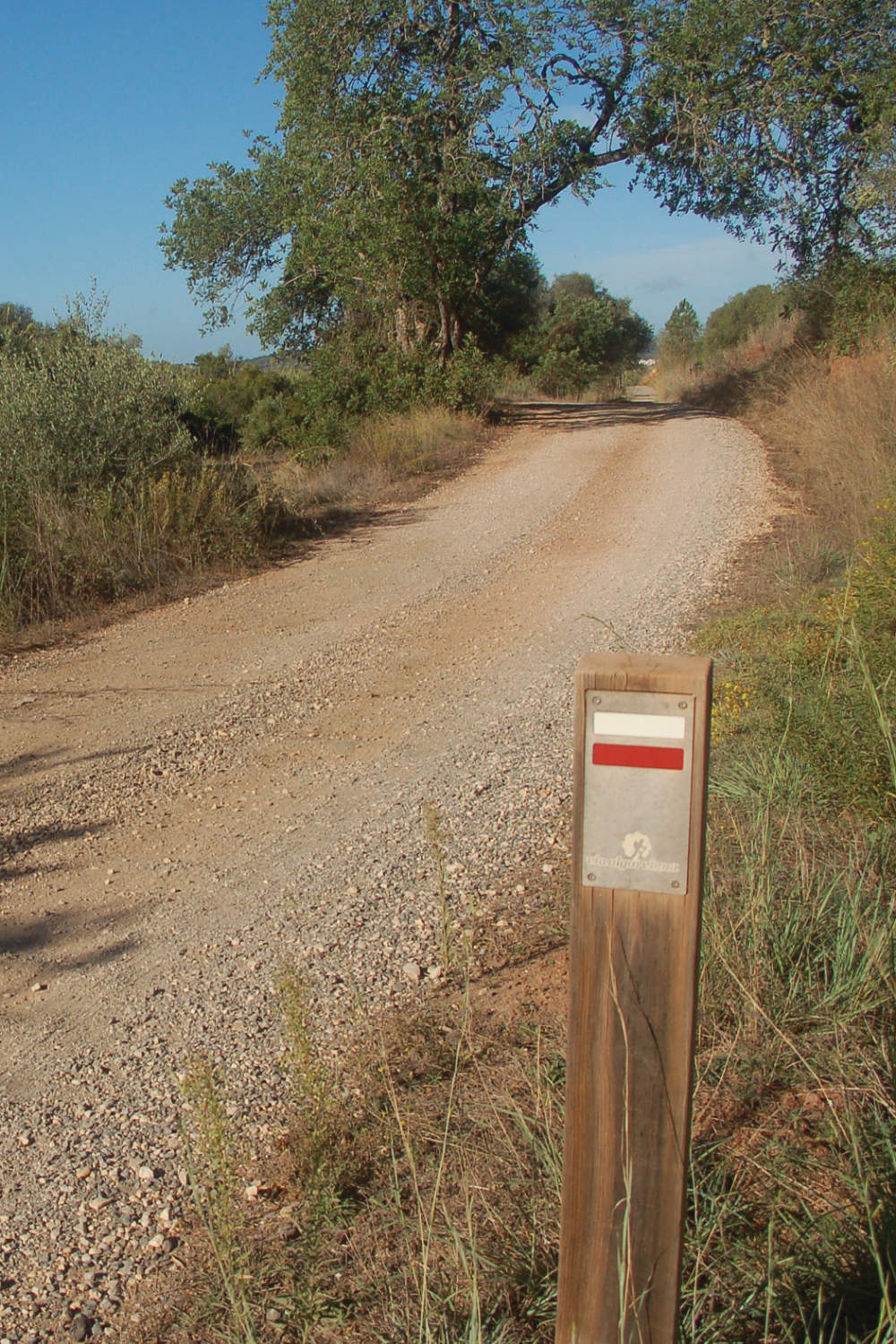 A vegetarian hiking cross-country needs plentiful, varied and healthy wholegrain food. If I head off on a long hike I always carry fresh, ripe fruit, but also dried fruit and nuts in my backpack. These days, the question of how humanity can feed itself in a healthy and climate-friendly way leads to heated discussions in most households. This is not just about the issue of meat, it’s about the current nutritional situation of humanity in particular. Because today already food is responsible for some 20 per cent of all CO2 emissions and 90 per cent of water consumption. All this when the focus of the heated discussion is on the issues of industrial agriculture and monoculture, intensive artificial irrigation and the transport of vegetables and fruit often across thousands of kilometres, and, well, the meat of animals. So many things could be practiced in a radically different way if small farmers organised themselves in local cooperatives and market the variety of their seasonal produce directly. What is needed is not rivalries but cooperations, and a term that most people are no longer prepared to accept: frugality.
A vegetarian hiking cross-country needs plentiful, varied and healthy wholegrain food. If I head off on a long hike I always carry fresh, ripe fruit, but also dried fruit and nuts in my backpack. These days, the question of how humanity can feed itself in a healthy and climate-friendly way leads to heated discussions in most households. This is not just about the issue of meat, it’s about the current nutritional situation of humanity in particular. Because today already food is responsible for some 20 per cent of all CO2 emissions and 90 per cent of water consumption. All this when the focus of the heated discussion is on the issues of industrial agriculture and monoculture, intensive artificial irrigation and the transport of vegetables and fruit often across thousands of kilometres, and, well, the meat of animals. So many things could be practiced in a radically different way if small farmers organised themselves in local cooperatives and market the variety of their seasonal produce directly. What is needed is not rivalries but cooperations, and a term that most people are no longer prepared to accept: frugality.
Here’s a practical example: hotels, guesthouses and restaurants could buy the eggs for their breakfast locally and from free-range production. Some hotels in rural areas might even be able to put all that unused space available in the hinterland to good use if they raised their own chickens. Creativity and courage in how to view work is required from the producer as much as from the Inland Revenue and the ASAE. It is well-known that civil servants have little vision when looking at climate-friendly food production. Their foresight usually ends at obsolete laws made by parliamentary deputies and a government with little understanding of reality in the countryside. Our democratically elected representatives tend to be legal folks, civil servants and teachers from towns and cities. When voting laws in the agricultural domain, many deputies unfamiliar with what really goes on will often only look at the subsidies that Brussels showers Portugal with, using the proverbial watering can, and have little interest in looking after small farmers operating on a local level. In most cases the only thing that counts are the lobbying interests of the agricultural industry. Small farmers’ real requirements are very different however. This is about healthy and balanced nutrition and food produced locally by family-run small businesses or farmers’ associations.
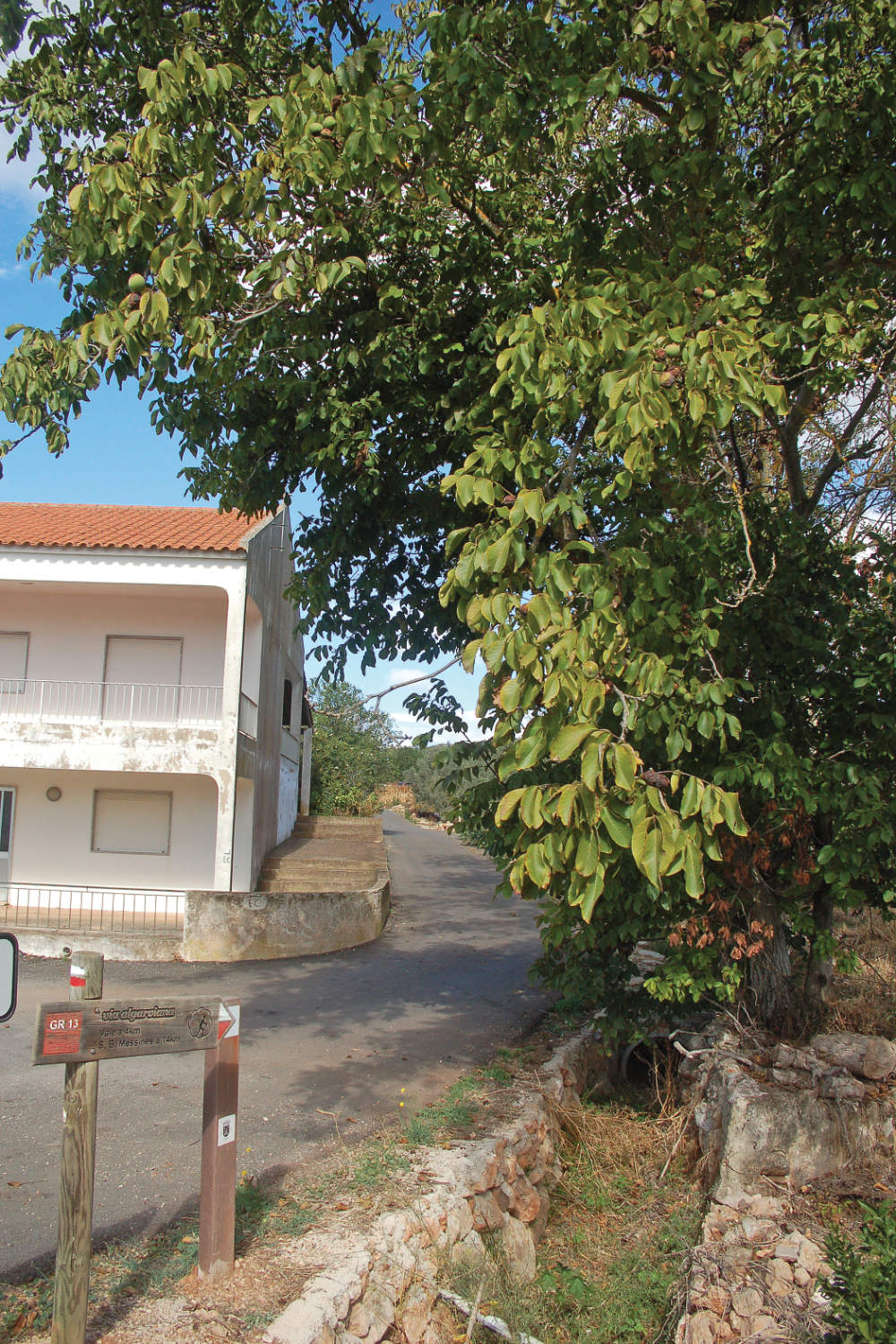 Portugal, which alongside Greece is the country with the most bureaucracy in Europe, needs a little tutoring for its politicians and civil servants and a slightly more sustainable perspective on the climate-friendly workings of its (agro)economy. Why should a restaurant not set up its own vegetable garden, why not keep a few chickens and goats, cutting the transport footprint of vegetarian food. A world where work is based on the division of labour and the desire to produce ever more and experience ever faster growth, throwing ever more food into the trash, are part-responsible for climate change and stand in the way of environmentally-friendly innovations to build a climate-neutral economy. In 2022, climate neutrality has to be at the heart of a companies and communities. How can this goal be achieved? By aiming for zero emissions with everything, whether at a private or professional level: including mobility, energy and food production.
Portugal, which alongside Greece is the country with the most bureaucracy in Europe, needs a little tutoring for its politicians and civil servants and a slightly more sustainable perspective on the climate-friendly workings of its (agro)economy. Why should a restaurant not set up its own vegetable garden, why not keep a few chickens and goats, cutting the transport footprint of vegetarian food. A world where work is based on the division of labour and the desire to produce ever more and experience ever faster growth, throwing ever more food into the trash, are part-responsible for climate change and stand in the way of environmentally-friendly innovations to build a climate-neutral economy. In 2022, climate neutrality has to be at the heart of a companies and communities. How can this goal be achieved? By aiming for zero emissions with everything, whether at a private or professional level: including mobility, energy and food production.
First things first: a kind of agriculture working naturally and without chemical fertilizer, without herbicides, pesticides and fungicides, a kind of agriculture respecting our different seasons and seasonal harvests – and of course involving produce travelling short distances. One example are the customers „Hikers“, direct consumers who enjoy holidaying in nature. Taking a closer look at the country they are walking through they are bound to ask themselves about the sense in certain attitudes?
For example, there is a plot of land next to the Alte Hotel where grass grows tall, unused and uncared for, but with a fence around it. Why and wherefore and for whom? Three to four goats and two sheep would graze it for free. A dozen chickens would increase the fertility of the soil by scraping and loosening it. A few fruit trees such as peach and apricot, oranges and other citrus fruit cultures would not only yield fruit for the hotel guests but also create shade for the land and its soil. Why then not plant some trees? The hotel could set up a compost heap for the restaurant kitchen here, to enable the organic waste to be turned into new soil and organic fertiliser which could be re-used in the garden, and to cultivate a few beds with spring-ripe strawberries and summer-ripe tomatoes, cucumbers and onions, herbs from basil to salad greens, climate-friendly, organic and creative. And the room really should have a glass bottle with water waiting for thirsty guests.
Sustainable innovation more often than not requires a qualified trainer taking on the training of the staff. Receptionists, chefs, waiters and cleaning staff could expand their horizons if they are offered continuous training in ecological thinking and action. Many of them have never even heard of permaculture. In the hotel and restaurant school people could learn together to create a biodiverse garden which will be an asset for the hotel, the restaurant and themselves. It’s a question of perspective how the management approaches the further training of the staff, what status is given to ecology and whether they want to feed their guests healthy food or whether they don’t put that much stock by that. In this way an unused plot of land could turn into a blossoming landscape. And that in turn would result in a win-win situation for everyone concerned, as well as representing a dynamic value-creation which always go hand in hand. Well trained staff is worth their weight in gold, and a near-empty hotel might then get to be near-fully booked…
Taking a recce walk around the hotel I see no solar panels on the roof? The issue of „climate neutrality“ includes avoiding CO2 emissions and autonomously-produced clean electricity. The showers in the bathrooms should have thermo water heaters installed using the sun to heat the water. The climate laws made by the Costa government (Lei de Bases de Clima) have not reached the provinces yet. That which is ecologically sustainable can definitely be of economic value too. If you produce your own clean power you don’t have to worry later on if electricity prices go through the roof from one day to the other. It’s a question of perspective which investment to prioritise, especially in a region where for over 300 days a year the sun is shining for free – and where water is becoming scarce.
First Book Moses, chapter 1, verse 28:
“And god blessed them,and God said unto them, Be fruitful, and multiply, and replenish the earth, and subdue it: and have dominion over the fish of the sea, and over the fowl of the air, and over every living thing that moveth upon the earth.”
Really?
Right. My washing is clean and has dried overnight. I dismantle the washing line and pack my backpack before heading to the dining room for breakfast. A few thoughts are entering my head while I’m queuing as if at some government office. There I am, my diary in hand, at the breakfast counter, waiting for someone to hand me a plate. Am I in a youth hostel or something? Looking out across the entire Western Algarve through the panorama window I ask myself how many kilos of waste are generated in a hotel on a daily basis, and how many tons of waste per year, once you start totting up all this small plastic packaging items for butter, jam and honey that are simply thrown away after their single use at breakfast and in the restaurant. „Waste of resources?“ I write down, and „Out of sight, out of mind?“. How many tons of CO2 are emitted in the production and transport of these foodstuffs, from the producer to the end consumer „Guest“, if these foodstuffs are bought in a centrally located Cash & Carry – as opposed to local decentralised production? The money spent would even stay in the economic cycle of the village, providing a boost to the local economy? Put differently, how much CO2 wasted on useless packaging could be saved if a country, an economy and a hotel were to actively take their cues from a locally organised economy, and take an active part in it? Any economy, any company needs someone who starts initiating ecological renewal, motivating other companies to join. And at the end of the day there it should be worth their while economically. Which makes the monthly energy bill an important indicator for sustainability. Those producing their own power learns to make themselves independent from an electricity bill and energy production based on dirty fuels.
On my way through the 120-km long heart of the Algarve that I’m crossing on foot, I notice more and more things. I’m also always overnighting in smaller guesthouses that are beginning to offer their hikers and other guests more local products at breakfast: from honey made by the local beekeeper and olive oil pressed at the local olive oil mill, all the way to homemade jams, fresh goat’s cheese, their own peanut butter, sardine pâté, bread and rolls from the neighbourhood bakery, alongside soaps made by the local soap maker for the bathroom. Which is why I notice the difference compared to the breakfast at the Alte Hotel. I hand back the artificial glued slices they call „fiambre“, and this industrial cheese represents neither Portugal nor the Algarve. The coffee comes from a machine with buttons that customers press themselves. The coffee is ground and the programmed box does the rest. And where does the milk come from? Out of a Tetra Pak, which once empty is thrown into the bin for me to see it again during my hike on the rubbish dump in Cortelha, 30 kms away. The Via Algarviana leads past the dump, which is how I’ll meet these old friends again. I carry a FFP2 mask in my backpack, because of the Covid pandemic, not yet quite over. But I might have to use it whether I want to or not because of the rubbish dump and the car exhaust fumes from fuels such as diesel and petrol, as my trail leads along tarred roads and beneath the Algarve motorway. And past service stations of couse. On my way from Alte to Salir I ask a service station owner in Benafim why he doesn’t make a power supply available for electric cars alongside petrol and diesel?
His reply? „If it was up to me I’d ban electric cars and everything would stay the way it is.“ Time to take to the road again methinks. The country will develop, or not.
 Eco123 Revista da Economia e Ecologia
Eco123 Revista da Economia e Ecologia

